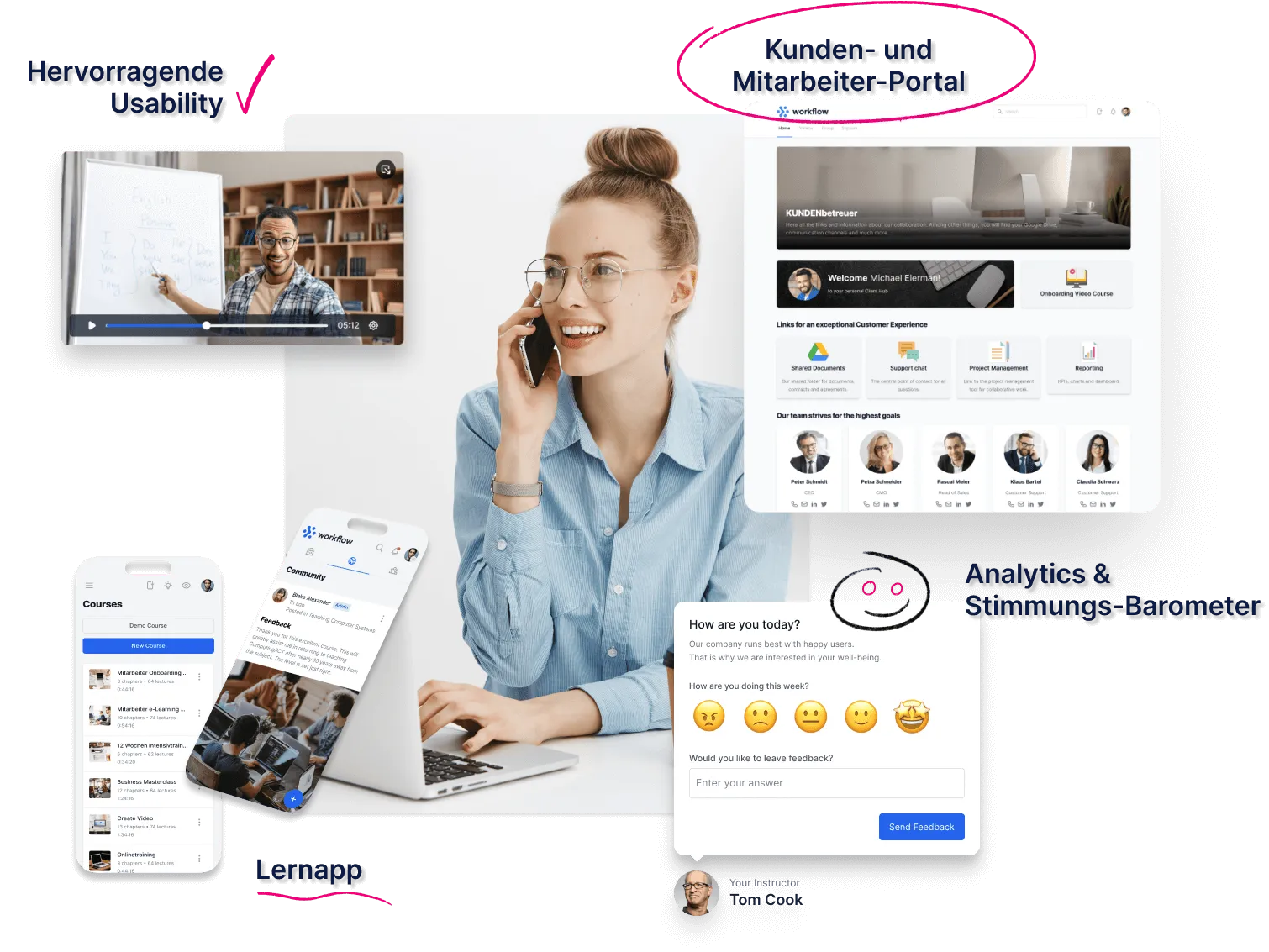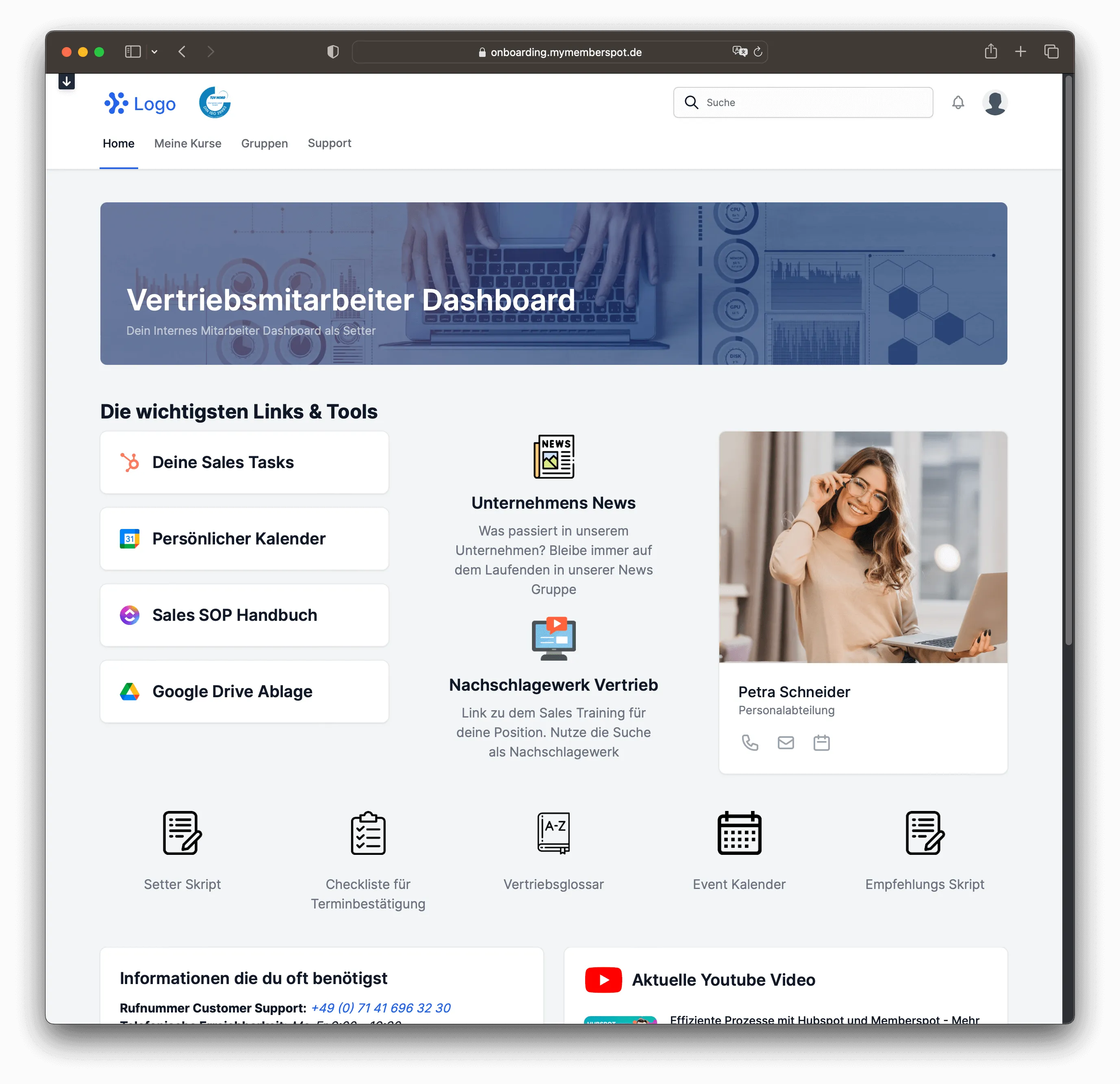
.svg)


Before Memberspot, there were three ways to create video courses for staff training. Either you invest a lot of time setting up plugins yourself to create WordPress member areas. You commission the development of an expensive custom solution and hope that the end result is good. Or book an all-in-one course platform.
With Memberspot, you have unlimited storage and can upload all online seminars and instructions directly to your employee training platform.
Memberspot, training platform for companies enables an engaging online learning experience, also on smartphones
.webp)

.webp)



.webp)






%20(1).webp)
Employee training is used for the further training of a company's employees, with the help of training courses both professional and social skills are to be trained and expanded. They are an important instrument of personnel development.
Employee training can take various forms: it can be held as a face-to-face event, individual training, group training or digital training.
Training is and will remain necessary, as employees can only perform certain tasks if their skills match the requirements.
As soon as requirements change, employees' skills need to be expanded. For example, when new software is introduced.
We are also all subject to technical progress and the constantly changing world of work, which justifies the need for employee training.
By imparting knowledge about new technologies or work approaches, companies benefit from increasing the work efficiency and productivity of their employees.
The main difference between face-to-face training and digital training is primarily the planning effort, which is generally higher for face-to-face training. Digital training courses also have to be planned and provided, but once they are online, employees can access the training courses from anywhere and at any time and the content does not have to be explained again and again by a lecturer in front of a new audience. This also eliminates the costs of catering, travel and any overnight stays.
The lack of flexibility can be a problem, especially for mandatory training courses that are held as face-to-face events. If compliance training courses are not held at companies in highly regulated industries due to contact restrictions, for example, this can be risky.
In addition, face-to-face training always requires administrative effort in terms of documentation and follow-up. It must be recorded which employees have completed which training courses and which certificates have been obtained as a result. With digital training courses, certificates of attendance are created automatically and learning progress can be easily logged and checked in the tool. Memberspot even offers quizzes and exams that can be created individually.
The idea behind digital training concepts is to use modern technologies to make training courses targeted, efficient and employee-friendly. Not to mention the enormous time and cost savings. Employees no longer have to travel to traditional face-to-face training courses, are no longer absent from the company for several days, no longer have any travel costs and can review what they have learned after the training course to deepen their knowledge or clarify any ambiguities. In-house training courses are certainly an alternative here, but these also involve a great deal of effort.
Digital training makes it possible to respond flexibly and individually to the respective requirements and the desired skills gain of each employee. In addition, participation is available from any location. This ensures that employees receive further training and compact training courses can also be offered spontaneously for specific areas.
This is just a small selection of topics that can fall under the term employee training. In fact, any type of further training measures for employees of a company can be described as employee training.
Working from home has become a trend in the world of work, not least due to coronavirus. More and more employees want to achieve a better work-life balance and are therefore increasingly looking for remote jobs.
But that's not all: if you look at working in virtual teams, there are other advantages to relocating the workplace. Team members, for example, are no longer selected primarily on the basis of their location, but on the basis of their skills. This opens up completely new opportunities for collaboration, particularly in corporations and companies that operate internationally.
This is why digital employee training is currently on the road to success. However, digital employee training makes sense not only for remote workplaces; using the potential of digital technologies to implement learning and knowledge transfer is extremely efficient and can benefit both companies and employees.
The advantages of face-to-face events and digital employee training courses can be easily combined, for example by organizing face-to-face training courses and providing employees with follow-up courses in which they can repeat, deepen and expand the knowledge imparted.
This makes sense, as a lot of content is often taught in a short space of time in face-to-face training courses, and it is almost impossible to remember it all. Online courses can be used to deepen the content on the respective topics, as employees can decide for themselves how much input they can absorb.
Especially if what has been learned is not used on a daily basis, but only in certain situations, this knowledge can then be accessed digitally as soon as it is needed.
This combination of face-to-face and digital training is known as blended learning.
